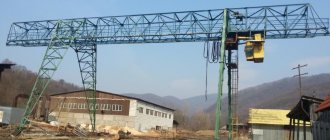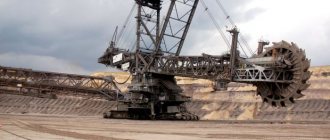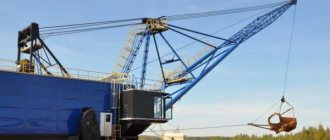Operating principle of gantry crane
The principle of operation of a gantry crane is based on a set of cyclic operations associated with lifting piece or containerized material, periodically moving the unit from the place of slinging the material to the place of unloading, and back. Transportation of raw materials, structures and movement of equipment occurs thanks to a special mechanism - a cargo trolley. It ensures the vehicle moves along the bridge span.
The main working operations performed by a gantry crane and their average duration:
- Capture. The load-handling device is inserted into the technological hole, which can be blind or through. The duration of the operation is on average 10-70 seconds.
- Climb. First, the load is raised to a height of up to 0.5 m so that the crane operator can verify the reliability of the fastening. When calculating the lifting time to a given height, the lifting speed of the holding device, acceleration and deceleration times, and lifting height are taken into account. The duration of the load lifting operation is from 25 to 50 seconds.
- Movement. The process time depends on the weight of the trolley, its carrying capacity and speed of movement, as well as the mass of the cargo load. The required time to move a trolley with a load is up to 20 seconds.
- Lowering. Depends on the height and speed of lowering, acceleration and deceleration of the load-handling member. According to a rough estimate, the duration of the process is from 15 to 30 seconds. It is allowed to lower the load only to the place provided for by the work project, where the tipping, falling or sliding of the transported elements is excluded.
- Releasing or unslinging cargo. Timing observations show that it takes 10-40 seconds to complete this work.
- Installing the hook in the upper position.
- Moving the empty cargo trolley to the zero position when the work is completely completed.
The set of technological operations for transporting cargo allows us to service large industrial facilities, while automating a number of production processes for creating finished products.
Our advantages
Own installation teams Guarantee of high-quality and timely installation of equipment
Own production Guarantee of high quality products
Only high-quality components Cooperation with leading European manufacturers guarantees the quality of components
Compliance with ISO 9001:2015 requirements
Flexible system of discountsSpecial conditions for regular customers
Urgent productionProduction from 5 working days
Extended warranty5 years warranty for our products
Wide geography of supplies Supply of products throughout the Russian Federation and the countries of the customs union
Purpose of gantry cranes
Gantry cranes are designed to carry out work on transporting piecemeal, large and long cargo. These can be concrete building structures, timber, rolled steel, industrial profiles and products. Bulk cargo such as coal, crushed stone, sand is moved by crane in a special container.
Gantry cranes of various types have a lifting capacity from 3 to 50 tons with a span of 10-40 meters. Such multifunctional operating parameters allow the units to be used for various purposes: in shipbuilding, mechanical engineering, at railway stations and warehouses.
Gantry crane device
Features of the design and production of a gantry lifting machine are indicated by the current GOST 7352, issued in 1988. The design features of the main components and mechanisms of gantry cranes are determined by their purpose - transportation of heavy dimensional materials. Therefore, the unit is a reliable metal structure.
GOST 7352-88 Electric gantry cranes
1 file 702.15 KB
Support structure
The gantry crane base structure consists of a bridge of supports. Machines with two-post supports are most often used, as they have a greater load capacity. The support unit is made of flat or spatial trusses, or sheet box structures. One of the supports has a rigid connection, and the second one has a hinged connection to the bridge. If the distance between the crane rails is less than 25 m, then both supports are rigidly secured. In this case, the installation of equipment is greatly simplified, but pushing forces arise and there is a chance of thermal deformations. With this mounting scheme, the crane control cabin is mounted on metal supports and is motionless.
The bridge, depending on the design, can be single-beam or double-beam. The bridge is a spatial structure that consists of two trusses. Units with a single-beam bridge have a load capacity of 5-10 tons. In this case, the beam can be represented by a rectangular cross-section made of rolled steel or a triangular cross-section made of pipes.
The main beams of the gantry crane are fixed to the supports, and the load ropes pass between them. The cargo trolley moves inside the building. The structure of a single-beam span structure may have braces. Then the cargo mechanism moves in the upper part of the span, and the load is suspended from the crossbeam.
Lifting and moving mechanisms
In the case when the equipment is installed on a cargo trolley, vertical movement occurs along the beam chords. If the mechanism is located permanently on the bridge, then special conditions for reeving the hoisting winch rope are provided for movement. It passes to the block through the cargo pulley, and then to the end beam through the second block. With this scheme, the total weight of the unit is reduced by an average of 20%, due to the reduction in the weight of the bridge and the weight of the cargo trolley.
Cargo trolleys differ in load capacity, speed of movement and design, they can be:
- Monorails. They move along channels on bridge spans.
- Double rails move along the rail track or I-beam shelves. The rails can be located at the top of the main beams or on brackets.
- Self-propelled. The movement mechanism is located on the device itself.
- Cable cars. The drive for movement and lifting is located on the bridge. The movement occurs with the help of rope traction created by a drum and a winch.
To prevent the device from hitting the end beams of the gantry crane bridge, wooden or rubber buffers are installed - limiters in the places of the end positions of the load trolley.
The gantry crane is moved using a wheel drive located on supports. It is an asynchronous mechanism with a motor and a two-phase motor, which is connected to the wheels. The cranes are equipped with a braking device and an anti-theft grip.
Superstructure
The span of a gantry crane consists of box-section span beams with rails for the running rollers of the load mechanism. On the outer sides, at the level of the upper belts, the buildings are supplemented with platforms. The final elements of the spans are connected to each other by end beams and rest on columns - supports. To ensure the stability of such a unit, additional connections are provided to connect the columns.
Types of gantry cranes
The classification of gantry cranes can be presented according to different criteria. According to their purpose, machines are divided into:
- Reloading machines. The carrying capacity of such machines is on average from 3.2 to 50 tons with a span height of up to 40 m. The loading and unloading speed reaches up to 16 minutes, depending on technological conditions. They are used for transporting materials and structures on open overpasses and areas of industrial enterprises for the production of metal and reinforced concrete products.
- Units for construction and installation work. The value of the load capacity parameter is higher, on average up to 400 tons. For the effective organization of the construction process, the machines have improved lifting speeds for moving cargo (up to 0.1 m/s), and the crane itself up to 1.5 m/min.
- Special. They have a carrying capacity of 300-500 tons, with an increased span height of 100-130 m, and a lifting height of up to 80 m. Their purpose is to serve special industrial enterprises, railways, and hydraulic stations.
The group of special machines includes self-erecting and containerized installations. The first ones are designed to facilitate the installation process, thanks to a mechanism for tightening each end of the support posts in pairs. Container cranes are equipped with a special load-handling device - a spreader. It allows you to move heavy containers, spending less time on loading and unloading.
Structural features underlie the classification of lifting equipment by type of span structure:
- Single beam. The span has a box-type cross-section and can be made of rolled metal pipes or a truss.
- Double beam. The load capacity and service life of such cranes are higher, since the design is smaller and easier to transport.
- Non-cantilever gantry crane. The cargo device moves along the main span.
- Single-console and double-console. The bridge extends beyond the crane runway on one or both sides, according to its name. Jib cranes have become widespread due to their improved strength characteristics and increased load capacity.
Types of gantry cranes according to the characteristics of the load-handling element can be:
- With hook one-horn or two-horn grip. They are used for transporting piece or container cargo using slings.
- Magnetic. The load-handling device is equipped with a magnet for lifting and moving metal lump materials and structures.
- Clamshell. A device for transporting bulk, fine-grained raw materials in the form of a ladle.
According to the type of drive, gantry cranes are divided into:
- Electric gantry crane. The working units are driven by an electric drive.
- With manual drive. It is lighter and has a manual gear hoist that moves the machine.
Manufacturers produce many modifications of gantry cranes, depending on the volume and scale of production, as well as the characteristics of the technological processes being performed.
Features of the crane installation
Construction of a gantry crane
Gantry cranes are a bridge type of crane equipment. They are based on supports. The name was given due to its resemblance to building structures - goats. The supports can be on one or two posts and move along guide rails on a solid concrete foundation. The efficiency and productivity of the crane installation depends on the quality and parameters of the rail track laying.
Moving the bridge on high supports provides high load capacity and the ability to work on large areas. Compared to overhead cranes, KK cranes are more mobile. A cargo trolley also moves along the bridge span, to which devices such as a magnet, hook, and traverse are attached.
Semi-gantry units moving along rail tracks of different laying levels are also used. KK cranes are equipped with devices that ensure the movement of the installation, trolley and lifting of loads.
Application
Operating a gantry crane involves risk, so only persons over 18 years of age who have undergone a medical examination, training and instruction are allowed to operate the machine. The crane operator must have a special permit to carry out work. Unauthorized persons are prohibited from being present at the work site.
The work area must be arranged in accordance with the work project. The production site is equipped with warning signs, access roads, and a separate unloading and loading area and installation area.
Before work, the gantry crane must be inspected and a technical inspection of the electrical equipment must be carried out. During operation, it is also necessary to monitor the condition of mechanisms and equipment. If a malfunction occurs or is detected, stop work immediately. Upon completion of the lifting operations, the gantry crane must be brought into working position at the zero position and de-energized.
A gantry crane is an efficient, high-performance transportation equipment. Thanks to reliable mechanisms, the movement and lifting of raw materials, materials and structures occurs at high speed, making it possible to automate many technological operations at production sites. The presence of various modifications allows you to use the appropriate type of equipment, depending on the scale and complexity of the work.
Electric motor
All work is carried out using a special three-phase electric motor, marked as MTF-211-6, which has a long service life.
It has the following technical characteristics:
- maximum power – 7.5 kW;
- shaft rotation speed at rated load – 940 rpm;
- rated current present in each phase is 18.1 A;
- the amount of current present in the rotor is 4.5 A;
- the voltage created between the individual rings is 3.3 V;
- Efficiency – 78.5%.
The MTF-211-6 engine is quite reliable. It is thanks to its high power and efficiency that the KKS-10 is distinguished by its high operating speed.
A gantry crane equipped with this electric motor can only be used under the following conditions:
- the height of the location above sea level should not exceed more than 1 km;
- dust content of the environment should not be more than 100 mg/m3;
- Suspended air or dust must not be conductive.
Important! It is also unacceptable to use motors of this type in an environment that destroys insulation, as this will lead to an interturn short circuit and motor failure. This type of electric motor can be used in areas designated as follows:
This type of electric motor can be used in areas designated as follows:
- U (moderate),
- T (tropical),
- O (general climatic),
- UHL (moderately cold).
The motor in question has a high class of dust and moisture protection, which makes it possible to place the KKS-10 crane directly on the street without fear of getting the live parts of the electric motor wet.










